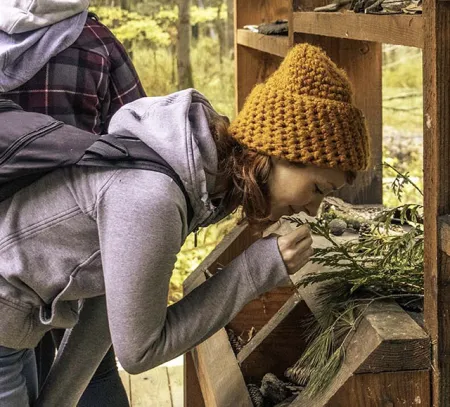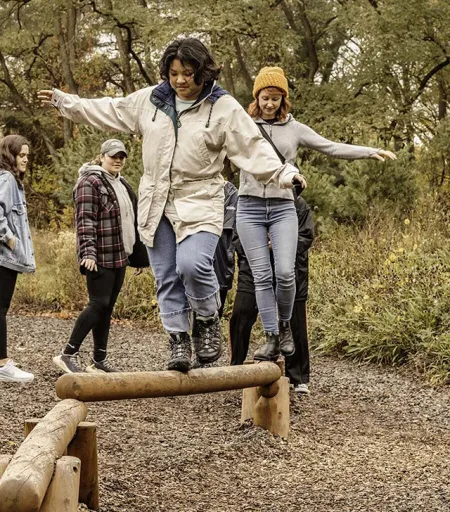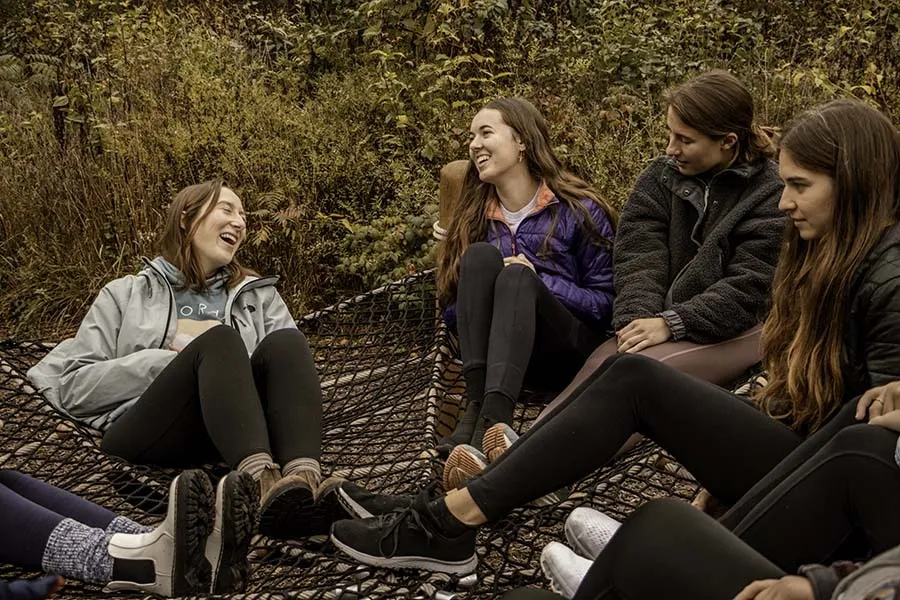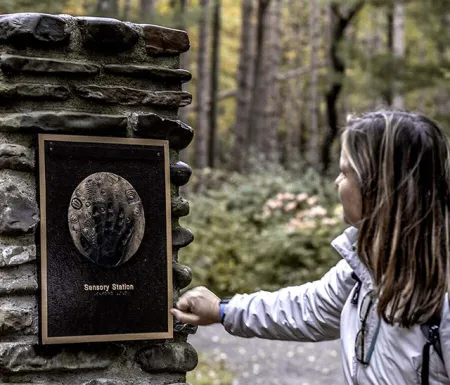While many people believe that nature is healing, one thing that is often overlooked about outdoor public spaces is their lack of accessibility for people with disabilities.
Connecting with Nature

Graduate occupational therapy students got to "hang out" at the various stations of the Autism Nature Trail, located in New York’s Letchworth Park. (Photo by Grace Condon '25)

Stations along the trail are designed to connect with different senses. (Photo by Grace Condon '25)
For occupational therapists who work with those who can’t easily access many outdoors spaces—hiking trails, parks, etc.— the need for designated spaces for play and leisure and the current deficit of them in their communities is a top concern. Many in the field are working diligently to find solutions and fund projects to implement those solutions. The Autism Nature Trail is one example of a solution.
Associate professor and occupational therapy graduate program chair Amie Germain collaborated with an inter-professional team for years to bring the trail to life. A 1-mile ADA-compliant nature trail in New York’s Letchworth Park, The Autism Nature Trail (ANT) is specifically designed for those on the autism spectrum and other developmental disabilities and contains eight different stations. Some of these stations include “alone zones” where individuals who are overstimulated or need a minute to decompress can have a dedicated space and break from the noises of nature.
The path also contains rock sculptures that let visitors know that they are still on the correct path.
The Autism Nature Trail has eight stations intended to help stimulate all the senses. Some of these stations also include “alone zones” where those who are overstimulated or need a minute can have their space and quiet.
- The Sensory Station consists of two gazebos with shelves made from wood. On the shelves you’ll find a variety of materials: pinecones, acorns, fossil rocks, animal furs, bark and more.
- The Sunshine Slope is a maze that goes up a slope that leads to full sun at the top. There are three green “cuddle cocoons” that students enjoyed lying in and spinning around.
- The Music Circle includes a wheelchair accessible performance stage and three nature-inspired instruments that produce harmonic frequencies that have a calming effect. There is also an “escape route” path that provides a shortcut back to the start of the path and parking area.
- The Reflection Knoll marks the halfway point of the trail and is complete with a circle of boulder seats with seven different animals carved into them.
- The Meadow Run and Climb offers four pieces of play equipment and an accessible grassy hill for visitors’ leisure and play.
- The Design Zone is in full shade and has wooden structures and natural building materials so visitors can construct forts, teepees, and “houses.” Students hung upside down from the structures and added to some of the pre-existing forts from prior visitors.
- The Playful Path is a series of looped paths made of log rounds and stones. The students had fun balancing on these materials and following one another through the loop in a line.
- The Celebration Station is the last stop on the trail. It has two chalkboards for visitors to share their thoughts, draw, or sign their names.
Germain helped garner financial support for this project and helped see it through from conception — which began nearly seven years ago — to completion.

Students got to walk the entire length of the trail, which is compliant with the Americans with Disabilities Act. (Photo by Grace Condon '25)
Germain was involved with designing the trail, collaborating with experts across different fields to make sure the trail would be accessible in every way possible. Speech pathologists considered the directional signs along the trail; while as an OT, Germain considered the terrain and the sensory properties of materials used.
With the trail officially open, Germain; Melinda Cozzolino, associate professor and chair of occupational therapy; and Dev Neu, assistant professor, brought second-year OT graduate students to visit the site.
“I’ve been working with this group for a long time,” said Germain of the project, which was delayed in part due to the COVID pandemic. “To finally get to bring a cohort of students to visit the finished trail and to see it come to fruition is really big.”
The cohort of students who accompanied the professors to the trail this fall have finished most of their coursework and completed 12 weeks of field work. Now that they are equipped with training and experience, Germain wanted the students to think about how they can use a place like the ANT therapeutically with individuals and groups receiving occupational therapy services.
Ithaca alumna and speech language pathologist, Gail Serventi '72, co-founder of the ANT and current chair of The ANT Alliance, steered the planning committee Germain served on. Her generosity helped make the trip possible. Serventi met the group at the ANT and provided a tour, discussion of on-going events, and is excited to continue to partner with Ithaca College graduate students for programming at the ANT. She was on hand to observe the students on their tour of the trail.

Germain hoped the trip would students to think about how they can use a place like the ANT therapeutically with patients.
Serventi described the loop configuration of the trail to the students as a thoughtful design that allows visitors to see where they came from and where they’re headed. This is especially important for those who might panic in the woods about where they are or have fears of the unknown.

At sensory stations, students got a chance to engage their textile sense of touch. (Photo by Grace Condon '25)
Germain believed that the significance of the trail could be felt by all those in attendance.
“I hope that the experience my graduate students have is [realizing] that nature has unifying properties that bring people together,” Germain said, “Thinking about, if we know not all aspects of nature are accessible, then what can we do to provide access to those places for everybody?”
For Kristin Ho ’23, one of the key takeaways from the event was learning that accessibility extends beyond building design; with the right resources, nature can be accessible.
“Seeing everyone’s inner child come out on the trail was absolutely amazing, ”Ho said. “There wasn’t a single person who didn’t have fun. It’s really a place for people of all ages.”